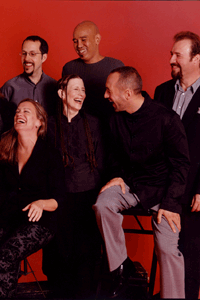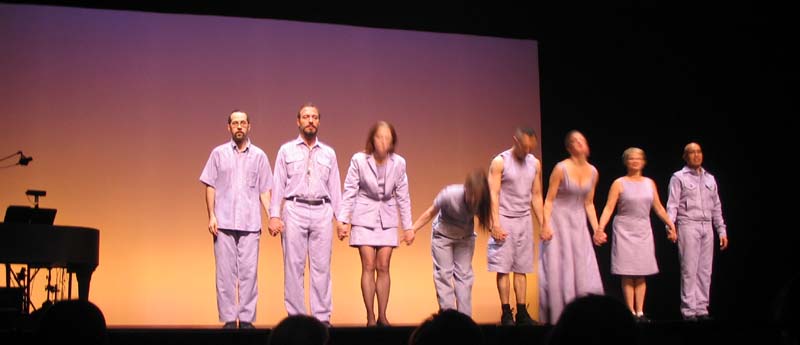 I'm not sure why experimental vocalist and composer Meredith Monk chose Fairfax for the Washington-area performance of her new multimedia work, Impermanence (2004-2005). Perhaps the venue at the George Mason University Center for the Fine Arts had the video, sound, and lighting capabilities required for the piece, but what it meant, inevitably, was a meager audience filling, by a rough estimate, one-third of the Concert Hall. Some left after only a few minutes, visibly perplexed or turned off, and many more left at intermission. This is unfortunate, because the impact of this multifaceted performance piece -- like much of Monk's œuvre, combining voice, movement, video, rhythm, and light -- should be universal, but it can be so only when it falls upon open minds.
I'm not sure why experimental vocalist and composer Meredith Monk chose Fairfax for the Washington-area performance of her new multimedia work, Impermanence (2004-2005). Perhaps the venue at the George Mason University Center for the Fine Arts had the video, sound, and lighting capabilities required for the piece, but what it meant, inevitably, was a meager audience filling, by a rough estimate, one-third of the Concert Hall. Some left after only a few minutes, visibly perplexed or turned off, and many more left at intermission. This is unfortunate, because the impact of this multifaceted performance piece -- like much of Monk's œuvre, combining voice, movement, video, rhythm, and light -- should be universal, but it can be so only when it falls upon open minds.As we took our seats, we heard recordings of a tune, Mieke's Melody #5, composed by choreographer Mieke van Hoek, Meredith Monk's partner, who died of cancer in 2002. Shortly after that tragic event in her life, Monk received an invitation from Rosetta Life, a group in England that connects patients in hospice care with artists. (This reminds me of another group I wrote about here in 2004, Musicians on Call, that brings classical musicians to play for the homebound.) Monk went to England, met with several patients, played her music for them, and talked to them. The recording we heard was of their timorous voices, singing the melody composed by Mieke van Hoek, each with an independent sense of pitch and rhythm. This was matched visually by video shots of faces, large silent closeups that melted from one into the next, which opened the performance.
Georgia Rowe, Monk's poignant 'Impermanence' teems with life (Contra Costa Times, February 9) Allan Ulrich, Meredith Monk's eerie vocals have led her to unique synthesis of arts (San Francisco Chronicle, February 13) M. C- (who will join my audience of one), Impermanence (The Standing Room, February 16) Steven Yi, Meredith Monk: Impermanence (Kunstmusik, February 16) Joshua Kosman, Monk's newest work an ode to loss: 'Impermanence' meditates on the passage of time (San Franciso Chronicle, February 17) Stephen Brookes, Meredith Monk Ensemble (Washington Post, February 27, under the heading of "Pop Music") |
In the second half, the whole group appeared again in the same cuts of clothing they had worn in the first half, but now all the costumes were of the same light gray or lavendar, recalling the "hospital gown" color we associate with the end of life all the "characters" have in common. That common nature is emphasized again by the video images shown in this half, again closeups of impassive faces, over which the camera hovers and then zooms in upon for a tight view of the right eye, all in the same way. That process is then reversed, beginning with a very close magnification and gradually zooming out to reveal the thing we could not recognize before, a cog, a leaf. At one point, some of the performers sat on the floor and looked, as the audience did, toward images of historical photographs, which always evoke the frailty of life, all those aspirations and proud personalities, vanished like the wind. In the closing scene, the music is reduced voice by voice (perhaps a tribute to the "Farewell" Symphony) as the performers sink to the floor and roll slowly off to the right side of the stage, like human waves back to the sea.

The best singing came from Katie Geissinger, who has a pure and pretty soprano voice and works also in "good old classical music" (an upcoming concert with the Orpheus Chamber Orchestra, for example). Theo Bleckmann has a nice baritone voice, too, and had far too much fun zooming around on roller skates at one point in the second half, to the sounds of a train horn. (He wore those shoes with hidden skate rollers in them that my friends and I loved in the 1980s.) John Hollenbeck's performance with mallets on a bicycle tire, silhouetted on the big screen by a light behind him, was a memorable Dada moment. The best group moment came at the opening of the second half, when the whole group gathered around the piano, playing at the keyboard or strumming or plucking the strings manually. Under a bright spot, they proceeded to reproduce the same music they had been playing but with their voices only. It was a good reminder of Meredith Monk's start, working exclusively with voice, a sound world that she has now considerably expanded with this latest work.
Here we are again, face to face with the crossover issue, but from a different angle. Monk's creative style combines many idioms and therefore is none of them. Listeners expecting any one of them alone -- classical composition, jazz extemporaneity, operatic singing, pop vocals, experimental dance, theater -- are likely to be disappointed. In effect, what I see as the major drawback of the crossover impulse for the high culture side of the equation is that it may actually decrease one's audience rather than increasing it. Here were singers, most of whose voices -- all of them assisted by microphone -- are not traditional classical voices, singing music that does not have any of the thorny, serial qualities that supposedly distance audiences. Indeed, the harmonic palette is -- like Adams or Glass -- a not particularly challenging vocabulary providing a basis for meditative repetition. Isn't that familiarity of the sounds of popular music exactly what should interest audiences? That being said, where Meredith Monk is concerned, I don't care. I will be an audience of one, if need be.
No comments:
Post a Comment